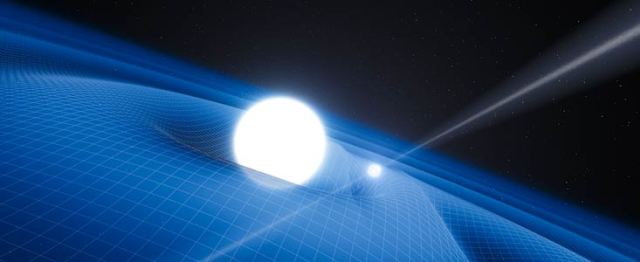Apr 26 2013
Astronomers have used ESO’s Very Large Telescope, along with radio telescopes around the world, to find and study a bizarre stellar pair consisting of the most massive neutron star confirmed so far, orbited by a white dwarf star.
 This artist’s impression shows the exotic double object that consists of a tiny, but very heavy neutron star that spins 25 times each second, orbited every two and a half hours by a white dwarf star. The neutron star is a pulsar named PSR J0348+0432 that is giving off radio waves that can be picked up on Earth by radio telescopes. Credit: ESO/L. Calçada
This artist’s impression shows the exotic double object that consists of a tiny, but very heavy neutron star that spins 25 times each second, orbited every two and a half hours by a white dwarf star. The neutron star is a pulsar named PSR J0348+0432 that is giving off radio waves that can be picked up on Earth by radio telescopes. Credit: ESO/L. Calçada
This strange new binary allows tests of Einstein’s theory of gravity — general relativity — in ways that were not possible up to now. So far the new observations exactly agree with the predictions from general relativity and are inconsistent with some alternative theories. The results will appear in the journal Science on 26 April 2013.
An international team has discovered an exotic double object that consists of a tiny, but unusually heavy neutron star that spins 25 times each second, orbited every two and a half hours by a white dwarf star. The neutron star is a pulsar that is giving off radio waves that can be picked up on Earth by radio telescopes. Although this unusual pair is very interesting in its own right it is also a unique laboratory for testing the limits of physical theories.
This pulsar is named PSR J0348+0432 and is the remains of a supernova explosion. It is twice as heavy as the Sun, but just 20 kilometres across. The gravity at its surface is more than 300 billion times stronger than that on Earth and at its centre every sugar-cubed-sized volume has more than one billion tonnes of matter squeezed into it. Its companion white dwarf star is only slightly less exotic; it is the glowing remains of a much lighter star that has lost its atmosphere and is slowly cooling.
“I was observing the system with ESO’s Very Large Telescope, looking for changes in the light emitted from the white dwarf caused by its motion around the pulsar,” says John Antoniadis, a PhD student at the Max Planck Institute for Radio Astronomy (MPIfR) in Bonn and lead author of the paper. “A quick on-the-spot analysis made me realise that the pulsar was quite a heavyweight. It is twice the mass of the Sun, making it the most massive neutron star that we know of and also an excellent laboratory for fundamental physics.”
Einstein’s general theory of relativity, which explains gravity as a consequence of the curvature of spacetime created by the presence of mass and energy, has withstood all tests since it was first published almost a century ago. But it cannot be the final explanation and must ultimately break down [1].
Physicists have devised other theories of gravity that make different predictions from general relativity. For some of these alternatives, these differences would only show up in extremely strong gravitational fields that cannot be found in the Solar System. In terms of gravity, PSR J0348+0432 is a truly extreme object, even compared to the other pulsars that have been used in high precision tests of Einstein’s general relativity [2]. In such strong gravitational fields small increases in the mass can lead to large changes in the spacetime around such objects. Up to now astronomers had no idea what would happen in the presence of such a massive neutron star as PSR J0348+0432. It offers the unique opportunity to push tests into new territory.
The team combined Very Large Telescope observations of the white dwarf with very precise timing of the pulsar from radio telescopes [3]. Such a close binary radiates gravitational waves and loses energy. This causes the orbital period to change very slightly and the predictions for this change from general relativity and other competing theories are different.
“Our radio observations were so precise that we have already been able to measure a change in the orbital period of 8 millionths of a second per year, exactly what Einstein’s theory predicts,” states Paulo Freire, another team member.
This is just the start of detailed studies of this unique object and astronomers will be using it to test general relativity to ever greater precision as time goes on.
Notes
[1] General relativity is not consistent with the other great theory of twentieth century physics, quantum mechanics. It also predicts singularities under some circumstances, where some quantities tend to infinity, such as the centre of a black hole.
[2] The first binary pulsar, PSR B1913+16, was discovered by Joseph Hooton Taylor, Jr. and Russell Hulse, for which they won the 1993 Nobel Prize in Physics. They accurately measured the changes in the properties of this remarkable object and showed that they were precisely consistent with the gravitational radiation energy losses predicted by general relativity.
[3] This work made use of data from the Effelsberg, Arecibo and Green Bank radio telescopes as well as the ESO Very Large Telescope and the William Herschel Telescope optical telescopes.